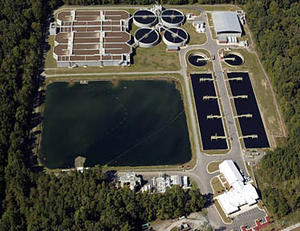Chemical plant securityNew survey shows many water, wastewater plants improve chemical security
New study says 554 drinking water and wastewater plants in 47 states have replaced extremely hazardous substances with safer and more secure chemicals or processes; at least 2,600 additional water and wastewater facilities still use large amounts of chlorine gas

Wastewater treatment plant in Durham County, North Carolina // Source: durhamcountync.gov
Here is the good news. A new survey by the Center for American Progress says 554 drinking water and wastewater plants in 47 states have replaced extremely hazardous substances with safer and more secure chemicals or processes. The survey was released just as the Senate Committee on Homeland Security and Government Affairs was hearing testimony on proposed chemical security regulation.
“These facilities show what can be done with proven technologies to remove chemical hazards from communities,” said Paul Orum, who conducted the survey as a consultant to the Center for American Progress. “Unfortunately, weak federal chemical security standards don’t encourage more treatment plants to reduce their hazards.”
Environmental Protection reports that DHS and other agencies warn that terrorists could use industrial chemicals as pre-positioned weapons. Current temporary Chemical Facility Anti-Terrorism Standards, or CFATS, exempt water utilities and do not require any facilities to look for safer and more secure chemicals and processes.
At least 2,600 additional water and wastewater facilities still use large amounts of chlorine gas.
“Leading facilities have converted, but progress is slow,” said Reece Rushing, director of Government Reform at the Center for American Progress. “We know how to dramatically reduce the risk of toxic terrorism. But more than 2,500 water facilities still use large amounts of potentially deadly chlorine gas, threatening millions of Americans. We can do better.”
Environmental Protection says the 554 converted water facilities are located in 47 states and the District of Columbia (all states except North Dakota, New Hampshire, and New Mexico). Of the 554 converted facilities, 235 treat drinking water, 315 treat wastewater, and four treat both. Of the 315 converted wastewater facilities, approximately 140 switched to ultraviolet disinfection and 175 switched to liquid bleach.
About two-thirds of U.S. wastewater plants already use a disinfectant other than chlorine gas, according to the U.S. Government Accountability Office (GAO). Drinking water utilities in at least 160 large U.S. cities already use liquid bleach.
Water utilities use chlorine to disinfect drinking water or wastewater. Utilities may avoid chlorine gas by switching to liquid chlorine bleach (sodium hypochlorite), which they may buy in bulk or generate on site. Wastewater plants may also avoid chlorine gas by switching to ultraviolet disinfection.
Some wastewater plants also avoid sulfur dioxide gas, used to dechlorinate, by switching to sodium bisulfite.
